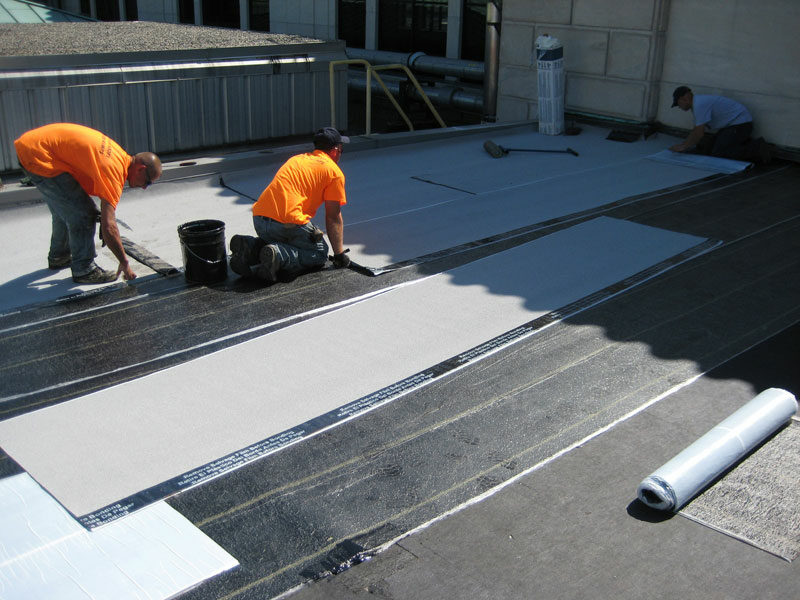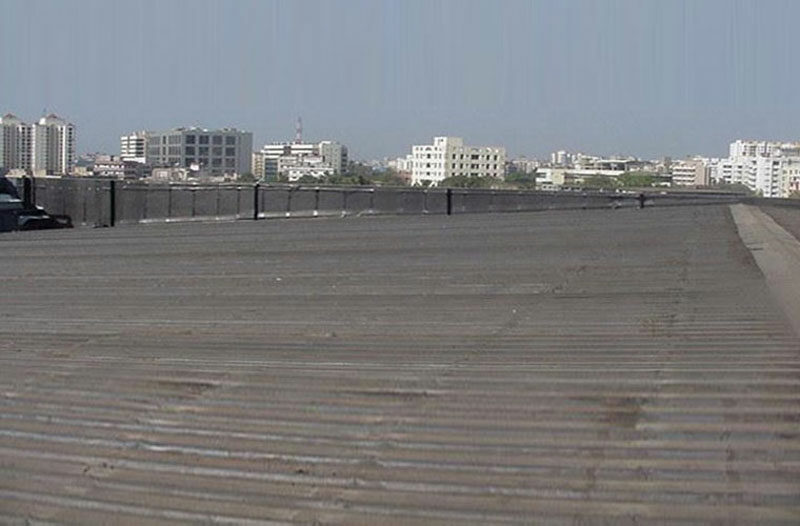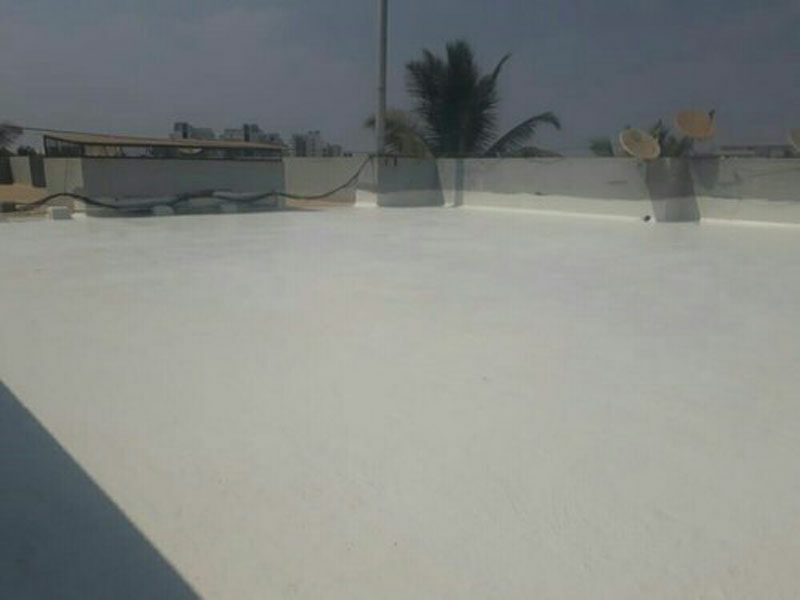A waterproofing membrane is a layer of water-tight material that is laid onto a surface to prevent water leaks or damage. Waterproofing membranes generally consist of liquid applied or pre-formed sheets. They can be adhered to or installed around the foundations (like a structural slab) to prevent water penetration. Whether it’s to protect your building’s basement or roof, waterproofing will help stop water from infiltrating your foundation and protect your structure from water damage. Waterproofing membrane is added to the concrete that will help make water ingress impenetrable as well as making it easy to maintain.
Different types of waterproofing membranes
Waterproofing membranes can be broadly categorized as Sheet Based Membranes and Liquid Applied Waterproofing Membranes. Sheet-based membranes come in the form of rolls. These are unrolled and laid on a firm surface. One of the most common sheet-based membranes is the bituminous waterproofing membrane. Liquid applied waterproofing membranes are the kind of membranes that come in the form of liquid that can be sprayed or brushed onto the surface. By spraying, the liquid forms a monolithic membrane, with no laps, welds or seams. Under these two broad categories, different types of waterproofing membranes are available in the market, each of them is explained below.
Self-adhesive modified bituminous membrane
Self-adhesive modified bituminous membranes are composed of asphalt, polymers, and tackifiers, and may contain mineral stabilizers. The products may be reinforced with fiberglass, polyester, or a combination of the two. Products designed for exposure to the elements are typically surfaced with mineral granules, coatings, films, or other opaque surfacing. The self-adhesive layer is protected with a release film or paper, which is removed during installation. Self-adhesive modified bituminous membranes are generally packaged and stored in cardboard boxes or they are protected with opaque wrapping.
Polymer-modified bitumen membrane
The most widespread materials for the creation of the waterproofing layer are the polymer-bitumen roll-fed sheet membranes. These materials could also be used as an underlay for pitched roofs and as a vapor barrier. The material withstands temperature fluctuations and high mechanical loads providing long-term, reliable and effective waterproofing. The polymer-modified bitumen sheet membrane provides additional flow resistance that makes it possible to use the material in a very hot climate. On the bottom side, the material is covered by a polymer film with special graphic elements, melting of which indicates the proper material heating. On the top side, the material is covered by a polymer film.
EPDM membrane
It is a preformed elastomeric waterproofing membrane made of high-quality EPDM rubber. It exhibits high tensile strength, elongation, tear strength and is resistant to weathering, heat aging, ozone, UV rays, acids, alkalis and oxygenated solvents. The installation is quick and more importantly, safe. Modern products come as a single component cementitious, polymer-modified non-reactive selective fiber-reinforced repair mortar to provide excellent properties as well as resistance to corrosion and carbonation and shrinkage cracking. This can be applied in thickness from 10 mm to 40 mm in vertical and 25 mm in an overhead situation. It is suitable to apply by hand trowel or by special mortar spray machine.
Thermoplastic membrane
Thermoplastic roof membranes set themselves apart from other commercial roofing systems. It is a blend of polypropylene, ethylene-propylene and is often reinforced with polyester. Sheets of TPO can contain UV absorbers, colorants, flame retardants or other add-ins to achieve required physical properties. Often white, TPO sheets can range in width from 6 to 12 feet and have varying thicknesses, usually 40 to 100 mil. Thermoplastic membranes can be less expensive than other roofing options.
Bituminous membrane
Hot melt liquid bituminous rubber blend structural waterproofing systems with an interlaid reinforcement can be used in roof and podium deck applications to provide a seamless waterproofing membrane for high green roofs and podiums, and are sometimes specified for winter applications as they can be laid at low temperatures.
Polyurethane membrane
These products come with a fiber-enhanced one component water-based polyurethane membrane that has been designed for a range of waterproofing applications where the membrane is to be covered over with tiles, screeds, concrete beds, etc They offer excellent adhesion properties overbuilding substrates including concrete, masonry, renders, cement sheeting, wet area sheet surfaces and plasterboard surfaces.
Polypropylene membrane
It is a special waterproofing material that is manufactured from Bitumen. They come in rolls. Each roll measures 10 metres by 1 metre and covers an area of 8.7 m². It is a very efficient and durable waterproofing material used in most constructions. It is a common waterproofing material used on concrete flat roofs . Apart from concrete roofs and low-pitched roofs, other areas of application are concrete gutters, basements and retaining walls.
PVC and TPO membrane
These are highly flexible sheet membrane systems that protect any concrete structure. It can be built as standard single-layer compartment systems up to the active control system to meet the highest demands. They are fully-bonded and offer high waterproofing safety and installation efficiency and are typically used for basements or below-grade areas.
Application of waterproofing membranes
Regardless of the scale, size, location or type of building, waterproofing membranes are an essential component necessary to protect the building’s structural integrity and its inhabitants. Its application areas include;
- Tanking/ basements
- Flat Roofs (including Green Roofs)
- Plant rooms
- Podiums and balconies
- Retaining walls
- Garden beds and planter boxes
- Concrete water tanks
- Containment and bunded areas
Factors to consider for the waterproofing membrane application
- Coating materials need to be abrasive resistant and accommodate building movement. Quite often this is misunderstood and unbonded screeds are placed over membranes that are applied too thin, resulting in mechanical abrasion. This mechanical abrasion is akin to trying to wear through the coating with a brick. Any thin spots, weak points or high spots can wear through, forming ruptures and blisters.
- Movement accommodation at bond breaker junctions is severely compromised when waterproofing is applied beneath a screed. The compacted screed restricts the coating movement when releasing from the bond breaker, as there is no active release zone. This can be addressed by installing a compressible foam rod to the perimeters, before placing the screed. This is further compromised when the required DFT is not achieved, reducing the membrane elongation tolerance drastically.
- Uneven film thickness is even more prone to elongation failure. Thicker coatings can restrict movement, where thinner applied coatings will tear under minimal movement. This is why filleting is not as successful as bond breaker systems. An even DFT [Dry Film Thickness] of coating, bonded to a compatible joint sealant, is restricted from stretching as the uneven fillet section of sealant allows free movement at the thin points, and restricts movement at thicker fillet zones.
- Most coating manufacturers require different ranges of minimum DFTs [Dry Film Thickness] under different circumstances. Internal wet areas may require a minimum DFT of 0.6 to 1mm for wall applications and 1 to 1.5mm for floors and horizontal surfaces. Balconies and podiums may require a minimum DFT at the range of 1.5 to 2mm, where lift pits, pools and planter boxes may require a minimum DFT up in the ranges of 2 to 3mm, depending on the coating material used.
- Low viscosity coatings must have at least 3 coats, where one cannot achieve anything greater than 0.5mm WFT, due to slump and souping of the coating. Even at 66% solids, we need to apply 3 coats to achieve the 0.99mm (1mm) DFT required for floor and horizontal surfaces.
- Coating DFT [Dry Film Thickness] is paramount to achieving the optimum performance as required by the manufacturer. Reduced coating thickness can result in abrasive damage and reduces elongation properties. Excessive thickness may result in re-emulsification and splitting during curing. Detailed substrate preparation will ensure even film thickness and performance.
Image Source: prweb.com, sondhienterprises.com, polygomma.com, greenshield.co.in, sika.com, concretecareindia.com, bronco.co.in, sandexwaterproofing.com










